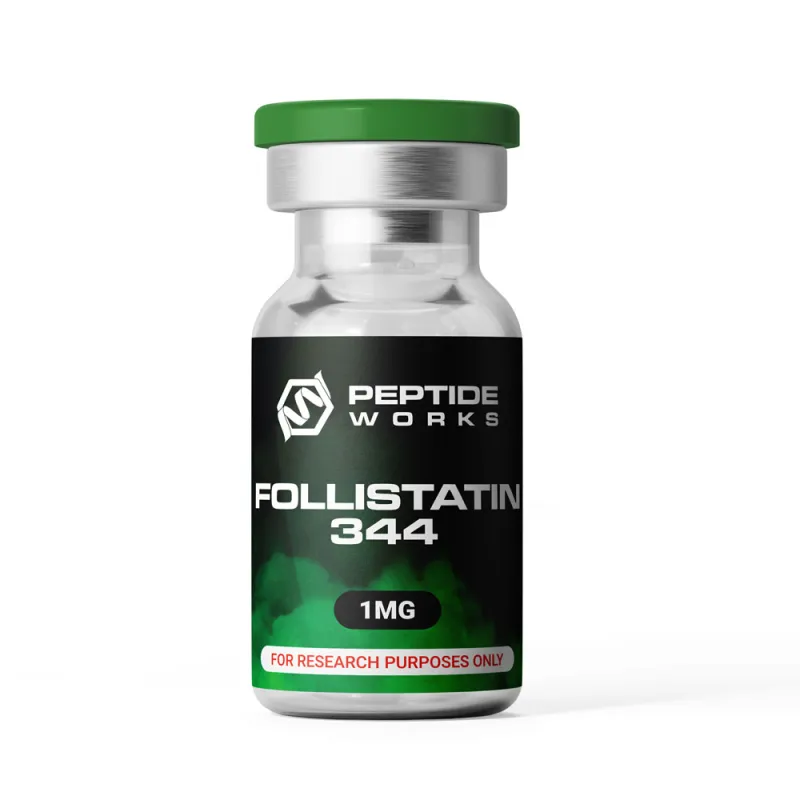
PROMO!
First order? Get 10% OFF with this code: 1storder
Written by

A myostatin blocker peptide is a research compound that stops myostatin protein function. Myostatin naturally limits muscle growth in all mammals.
These peptides block myostatin by binding to its receptors. Research studies show these compounds can increase muscle mass in laboratory settings.
Scientists use myostatin blocker peptide to study muscle wasting diseases. Follistatin peptide is another key research that inhibits myostatin activity.
Peptide Works supplies these research-grade peptides to qualified laboratories worldwide. To understand how these blocking compounds work, we need to examine the biological process they’re designed to interrupt.
Explore GDF-8 Myostatin from Peptide Works, a key muscle growth regulator studied for its role in inhibiting muscle development through TGF-β signaling pathways.

Myostatin naturally limits muscle growth through TGF-beta superfamily signaling pathways. This protein binds to activin receptor type IIB on muscle cells first.
The binding activates SMAD2 and SMAD3 proteins inside muscle cells. These activated SMAD proteins then block MyoD and myogenic regulatory factors.
Myostatin also inhibits the Akt/mTOR pathway that promotes protein synthesis. At the same time, it activates ubiquitin-proteasome systems for protein breakdown.
This dual action reduces both muscle protein creation and increases protein destruction. Research with myostatin blocker peptide compounds helps scientists understand these natural limitation mechanisms.
SMAD3 proteins directly bind to MyoD transcription factors inside muscle cells. This binding prevents MyoD from forming proper complexes with E12/E47 proteins.
SMAD3 also blocks MEF2 transcription factors that control muscle gene expression. The protein displaces GRIP-1 coactivators from muscle gene promoters completely.
SMAD3 interferes with E-box binding sites on muscle-specific DNA sequences. Research shows these SMAD-mediated blocks create multiple points of muscle gene suppression.
Scientists study how myostatin blocker peptide compounds can overcome these transcriptional barriers. This understanding helps researchers design more effective inhibition strategies for muscle studies.
Understanding the E-box binding sites mentioned reveals the specific DNA targets where muscle gene suppression occurs.

E-box binding sites are specific DNA sequences found in muscle gene promoters. These sites have the consensus sequence CANNTG, where N represents any nucleotide.
Basic helix-loop-helix proteins like MyoD bind to these E-box sequences directly. When MyoD binds to E-boxes, it activates muscle-specific gene transcription normally.
However, SMAD3 proteins can interfere with this E-box binding process. GDF-8 myostatin signaling disrupts normal E-box function through SMAD pathways.
Follistatin peptide research shows alternative approaches that bypass E-box interference mechanisms. Understanding E-box sites helps researchers design better myostatin blocker peptide strategies.
The GDF-8 myostatin mentioned represents the scientific name for myostatin, and its specific disruption mechanism warrants detailed explanation.
GDF-8 myostatin disrupts E-box function through SMAD3-mediated transcriptional interference mechanisms. After binding to ActRIIB receptors, GDF-8 activates SMAD2 and SMAD3 proteins.
These activated SMAD3 proteins then compete directly with MyoD for E-box binding sites. SMAD3 forms inhibitory complexes that block MyoD from accessing CANNTG sequences effectively.
The protein also recruits histone deacetylases that silence muscle gene promoters. GDF-8 additionally disrupts the formation of MyoD-E47 heterodimers required for transcription.
Research shows myostatin blocker peptide compounds can prevent this E-box interference. This disruption mechanism explains why GDF-8 effectively shuts down muscle gene expression.
While synthetic myostatin blockers target these pathways, follistatin offers an alternative approach with distinct mechanisms and characteristics.

Follistatin works differently than myostatin blocker peptides in several key ways. Follistatin binds directly to myostatin protein before it reaches muscle cells.
Myostatin blocker peptide compounds target receptors on muscle cell surfaces instead. This makes follistatin a direct antagonist while blocker peptides are receptor blockers.
Follistatin also blocks activin proteins, affecting more biological pathways than targeted peptides. Research shows follistatin binds myostatin more strongly than synthetic blocker compounds.
However, this broader effect may cause unwanted interactions in research studies. Scientists can obtain both compound types from suppliers like Peptide Works for comparative research.
The broader effects of follistatin mentioned create important considerations for research applications that scientists must understand.
Discover Follistatin Peptide from Peptide Works, a potent myostatin and activin inhibitor researched for its broad effects on muscle development and hormonal pathways.
Follistatin can cause unwanted interactions through its effects on reproductive hormone pathways. Research shows follistatin disrupts the pituitary-gonadal axis by inhibiting FSH release.
This broad activin inhibition affects fertility mechanisms beyond muscle growth regulation. Follistatin also binds to heparin sulfate proteoglycans, causing cell surface complications.
Studies indicate follistatin may promote certain cancer cell types in some research models through activin pathway interference.
These off-target effects make myostatin blocker peptide compounds more selective for muscle research. Scientists must consider these broader TGF-beta superfamily interactions when designing follistatin studies.
The future of myostatin blocker peptide development looks extremely promising for therapeutic applications. Major pharmaceutical companies are currently testing multiple myostatin inhibitor drugs in clinical trials.
These compounds show potential for treating muscle wasting diseases, sarcopenia, and obesity. Scientists are developing oral myostatin inhibitors with improved bioavailability and therapeutic effectiveness.
Advanced formulations offer better stability and prolonged muscle activation effects in studies. Myostatin blocker peptide compounds may revolutionize metabolic health and muscle regeneration treatments.
Peptide Works continues supplying high-grade compounds to support these advancing therapeutic developments worldwide.
All products discussed are supplied for research purposes only and are not intended for human use.
[1] Lee EJ, Shaikh S, Baig MH, Park SY, Lim JH, Ahmad SS, Ali S, Ahmad K, Choi I. MIF1 and MIF2 Myostatin Peptide Inhibitors as Potent Muscle Mass Regulators. Int J Mol Sci. 2022 Apr 11;23(8):4222.
[2] Tsuchida K. Myostatin inhibition by a follistatin-derived peptide ameliorates the pathophysiology of muscular dystrophy model mice. Acta Myol. 2008 Jul;27(1):14-8.
[3] Rodino-Klapac LR, Haidet AM, Kota J, Handy C, Kaspar BK, Mendell JR. Inhibition of myostatin with emphasis on follistatin as a therapy for muscle disease. Muscle Nerve. 2009 Mar;39(3):283-96.
[4] Elkasrawy MN, Hamrick MW. Myostatin (GDF-8) as a key factor linking muscle mass and bone structure. J Musculoskelet Neuronal Interact. 2010 Mar;10(1):56-63.
ALL CONTENT AND PRODUCT INFORMATION AVAILABLE ON THIS WEBSITE IS FOR EDUCATIONAL PURPOSES ONLY.
DISCLAIMER: These products are intended solely as a research chemical only. This classification allows for their use only for research development and laboratory studies. The information available on our Peptide Works website: https://peptide-works.com/ is provided for educational purposes only. These products are not for human or animal use or consumption in any manner. Handling of these products should be limited to suitably qualified professionals. They are not to be classified as a drug, food, cosmetic, or medicinal product and must not be mislabelled or used as such.
Peptide Works
Related Articles

Best Peptides for Women in Perimenopause: From Libido to Energy
Do you feel drained, struggle with focus, or notice your drive slipping during perimenopause? These changes are some of the

PT-141 for Women in Perimenopause: A Breakthrough for Low Libido
Perimenopause can bring more than just physical changes it often affects how women feel about intimacy, confidence, and connection. Many

Can Vitamin B12 Immune System Support Enhance the Effects of Thymosin Alpha-1?
The Vitamin B12 immune system link is important because this vitamin plays a crucial role in DNA synthesis, methylation, energy